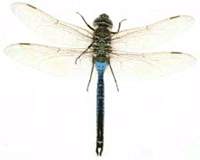There are about
5,000 species of Odonata (dragonflies and damselflies) in the world.
About 147 species have been reported to be present in Illinois.
Anatomy
of Dragonflies and Damselflies
 Being
insects, dragonflies and damselflies have an exoskeleton, three pairs
of legs, and three body parts: head, thorax, and abdomen. Both have
large, compound eyes, short, bristle-like antennae, and four long membranous
wings.Damselflies
can be distinguished by their more delicate features and by their carrying
their wings vertically over their abdomen. Dragonflies are often more
robust in structure and they carry their wings horizontally when resting.
Being
insects, dragonflies and damselflies have an exoskeleton, three pairs
of legs, and three body parts: head, thorax, and abdomen. Both have
large, compound eyes, short, bristle-like antennae, and four long membranous
wings.Damselflies
can be distinguished by their more delicate features and by their carrying
their wings vertically over their abdomen. Dragonflies are often more
robust in structure and they carry their wings horizontally when resting.
Green
Darner (Anax junius)
Life Cycle
 The
stages of dragonflies and damselflies are the egg, the larva (nymph),
and the adult. In the spring the female adult deposits eggs in floating
plant debris, or in a few species, such as the darner, has an ovipositor
with which she deposits eggs into the stems of water plants.
The
stages of dragonflies and damselflies are the egg, the larva (nymph),
and the adult. In the spring the female adult deposits eggs in floating
plant debris, or in a few species, such as the darner, has an ovipositor
with which she deposits eggs into the stems of water plants.
Slender Spreadwing Damselfly (Lestes rectangulares)
Three weeks later,
the young larva emerges into the water, where it feeds on small aquatic
animals and molts several times over about eleven months. Then the mature
nymph walks out of the water and splits open its skin, from which a
winged adult emerges. An adult dragonfly spends most of its time over
land feeding on insects as it flies.
Related Activities:
Dragonfly Anatomy (Art) (html)
(pdf)
Dragonfly Poster (html) (pdf)

